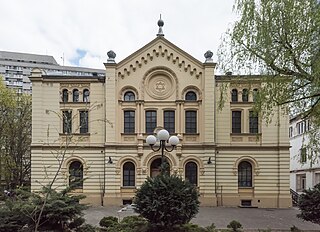
The Budapest Ghetto was a Nazi ghetto set up in Budapest, Hungary, where Jews were forced to relocate by a decree of the Government of National Unity led by the fascist Arrow cross party during the final stages of World War II. The ghetto existed only from November 29, 1944 to January 17, 1945.

Kiskörút or Small Boulevard is a major thoroughfare in Budapest. It forms an incomplete semicircle between Deák Square and Fővám Square. It is the border of the southern part of District 5, the innermost district of Pest. As opposed to Nagykörút, it only touches the Danube at its southern end.

The West London Synagogue of British Jews, abbreviated WLS, is a synagogue and congregation, affiliated to Reform Judaism, near Marble Arch in central London. It was established on 15 April 1840. The current synagogue building in Upper Berkeley Street, dedicated in 1870, is Grade II listed. It is one of the oldest synagogues in the United Kingdom and is the oldest house of prayer affiliated with the Movement for Reform Judaism.

Szeghalom is a town in Békés county, in southeastern Hungary.

The Great Synagogue of Warsaw was one of the grandest synagogues constructed in Poland in the 19th century. At the time of its opening, it was the largest Jewish house of worship in the world. It was located on Tłomackie street in Warsaw.

Congregation Baith Israel Anshei Emes, more commonly known as the Kane Street Synagogue, is an egalitarian Conservative synagogue located at 236 Kane Street in Cobble Hill, Brooklyn, New York City, United States. It is currently the oldest continuously operating synagogue in Brooklyn.

The Nożyk Synagogue is the only surviving prewar Jewish house of prayer in Warsaw, Poland. It was built in 1898-1902 and was restored after World War II. It is still operational and currently houses the Warsaw Jewish Commune, as well as other Jewish organizations.

The Dohány Street Synagogue, also known as the Great Synagogue or Tabakgasse Synagogue, is a historical building in Erzsébetváros, the 7th district of Budapest, Hungary. It is the largest synagogue in Europe, seating 3,000 people and is a centre of Neolog Judaism.

The Shoes on the Danube Bank is a memorial erected on 16 April 2005, in Budapest, Hungary. Conceived by film director Can Togay, he created it on the east bank of the Danube River with sculptor Gyula Pauer to honour the Jews who were massacred by Fascist Hungarian militia belonging to the Arrow Cross Party in Budapest during the Second World War. They were ordered to take off their shoes, and were shot at the edge of the water so that their bodies fell into the river and were carried away. The memorial represents their shoes left behind on the bank.

The Jewish Museum of Florida-FIU is located in two restored historic buildings that were formerly synagogues, at 301 & 311 Washington Ave., in Miami Beach, Florida. The main museum building, at 301 Washington Ave., was built in 1936, is on the National Register of Historic Places, has Art Deco features, a copper dome, a marble bimah and 80 stained glass windows. The adjacent building located at 311 Washington, which served as Miami Beach's first synagogue, was purchased by the museum in 2005 and restored in 2007 as a museum expansion.

Abony is a town in Pest County, Hungary.

Jewish ghettos in Europe were neighbourhoods of European cities in which Jews were permitted to live. In addition to being confined to the ghettos, Jews were placed under strict regulations as well as restrictions in many European cities. The character of ghettos fluctuated over the centuries. In some cases, they comprised a Jewish quarter, the area of a city traditionally inhabited by Jews. In many instances, ghettos were places of terrible poverty and during periods of population growth, ghettos had narrow streets and small, crowded houses. Residents had their own justice system. Around the ghetto stood walls that, during pogroms, were closed from inside to protect the community, but from the outside during Christmas, Pesach, and Easter Week to prevent the Jews from leaving at those times.

Historic synagogues include synagogues that date back to ancient times and synagogues that represent the earliest Jewish presence in cities around the world. Some synagogues were destroyed and rebuilt several times on the same site. Others were converted into churches and mosques or used for other purposes.

The Jewish Architectural Heritage Foundation is a non-profit, Staten Island, New York-based corporation which assumes responsibility for maintaining, restoring, renovating and building Jewish heritage buildings and monuments on a global scale. It has 501(c)(3) tax-exempt status.

Temple Beth-El is a Reform synagogue in Jersey City, New Jersey. located at 2419 Kennedy Boulevard in the Bergen Section.

Sandy's Row Synagogue is a historic Grade II listed synagogue and former Christian church in the East End of London. Built by refugee French Huguenots in 1766, it was later converted into a Baptist chapel and in 1867 was acquired by a Jewish congregation. It is the oldest surviving Ashkenazi synagogue in London.
The Baia Mare ghetto was one of the Nazi-era ghettos for European Jews during World War II. It was located in the city of Baia Mare in Maramureș County, Transylvania, now part of Romania but administered as part of Szatmár County by the Kingdom of Hungary from the 1940 Second Vienna Award's grant of Northern Transylvania until late 1944. It was active in the spring of 1944, following Operation Margarethe.
The Satu Mare ghetto was one of the Nazi-era ghettos for European Jews during World War II. It was located in the city of Satu Mare in Satu Mare County, Transylvania, now part of Romania, but administered as part of Szatmár County by the Kingdom of Hungary from the 1940 Second Vienna Award's grant of Northern Transylvania until late 1944. The ghetto was active in the spring of 1944, following Operation Margarethe.

The Shanghai Jewish Refugees Museum is a museum commemorating the Jewish refugees who lived in Shanghai during World War II after fleeing Europe to escape the Holocaust. It is located at the former Ohel Moshe or Moishe Synagogue, in the Tilanqiao Historic Area of Hongkou district, Shanghai, China. The museum features documents, photographs, films, and personal items documenting the lives of some of the more than 20,000 Jewish residents of the Restricted Sector for Stateless Refugees, better known as the Shanghai Ghetto, during the Japanese occupation of Shanghai.

The Gherla Synagogue is a synagogue located in Gherla in northern Romania. The building was constructed in 1903 and was in danger of collapse in 2012 when fund raising was commenced to complete structural repairs.

























